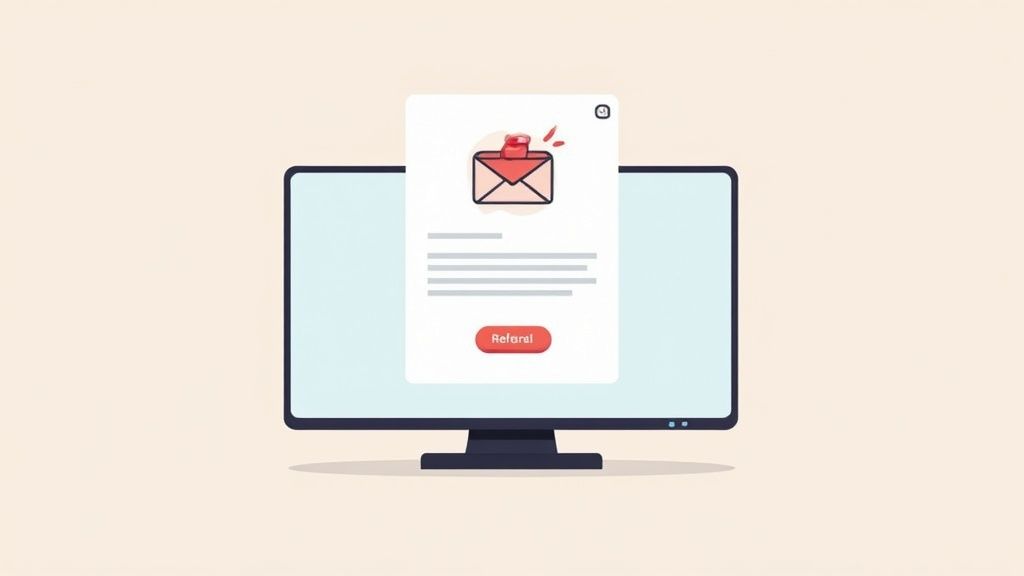Boost Your Business with a Referral Program Email Strategy
The Psychology Behind Effective Referral Program Emails

Referral program emails leverage core principles of human behavior, specifically social proof and trust. Consider this: would you be more inclined to try a new restaurant based on a billboard or a friend's glowing review? Recommendations from trusted sources hold significantly more sway than general marketing. This principle underpins successful referral programs.
Effective referral program emails also tap into the principle of reciprocity. When someone recommends a product or service they value, there's often a natural inclination to reciprocate. Offering incentives further strengthens this, establishing a mutually beneficial arrangement. The referrer is rewarded for sharing, while the referred individual gains access to a potentially useful product or service.
Understanding intrinsic and extrinsic motivation is crucial for a thriving referral program. Intrinsic motivation originates internally – the desire to share something valuable with a friend. Extrinsic motivation stems from external rewards, such as discounts or credits. Well-crafted emails balance these two, appealing to both altruism and self-interest. For example, framing a reward as mutually beneficial can engage both types of motivation.
The reach of referral program emails also contributes to their impact. Referral programs, including email-based ones, demonstrate impressive participation rates, with roughly 44% of consumers actively involved. Emails specifically account for approximately 30% of successful referral shares. Remarkably, companies using robust referral programs often see referrals generate up to 10% of their total revenue. Find more detailed statistics here. This underscores the significant growth potential of referral emails for businesses. In essence, these emails combine trust, reciprocity, and motivation for impactful marketing.
Anatomy of High-Converting Referral Program Emails

A well-structured referral program email is essential for encouraging participation. Every part of the email, from the subject line to the call to action, needs a strategic design. Consider it a concise sales pitch designed to capture attention, generate interest, and ultimately, motivate action.
The Importance of a Powerful Subject Line
The subject line is your first, and often only, opportunity to make an impression. It's the doorway to your message. A compelling subject line dramatically improves your open rates. Subject lines that create a feeling of urgency or exclusivity tend to do well. Phrases like "Exclusive offer for you and a friend" or "Limited-time referral bonus inside" can be particularly effective.
Crafting Compelling Copy That Converts
Once someone opens the email, the copy needs to explain the referral program clearly and concisely. This means highlighting the benefits for both the referrer and their friend. Avoid technical jargon; keep the language simple and easy to understand. Imagine you're explaining the program to a friend – your language should be clear, concise, and engaging.
The Power of a Clear Call to Action
A clear and compelling call to action is crucial for driving conversions. The button should be visually prominent and use action-oriented words. Instead of a generic "Submit" button, consider using "Get Your Reward" or "Share with Friends." Make it easy to participate to see higher conversion rates.
Optimizing for Mobile Devices
Since many people open emails on their phones, ensuring your referral program email is mobile-friendly is essential. This means using responsive design that adapts to different screen sizes. If your email doesn't display correctly on a phone, you risk losing referrals.
Effective Reward Communication
Clearly communicating the rewards is crucial for motivating participation. Emphasize the value of the incentive, whether it's a discount, credit, or free product. This can be done with visually appealing graphics or concise, benefit-driven language.
Building Trust and Credibility
Using social proof, like testimonials or user reviews, can significantly improve your referral email's effectiveness. This builds trust and makes potential referrers more likely to participate.
To help illustrate the impact of various email elements, let's look at the following table:
Referral Email Component Effectiveness
This table compares the impact of different referral email elements on key performance metrics.
| Email Component | Impact on Open Rate | Impact on Click-Through Rate | Impact on Conversion Rate | Best Practice |
|---|---|---|---|---|
| Subject Line | Significant - can increase by up to 50% | Moderate | Low | Use urgency or exclusivity |
| Compelling Copy | Low | Significant - can increase by up to 30% | Moderate | Clearly explain benefits |
| Call to Action | Low | Moderate | Significant - can increase by up to 20% | Use action-oriented language |
| Mobile Optimization | Moderate | Moderate | Moderate | Use responsive design |
| Reward Communication | Low | Moderate | Significant - can increase by up to 25% | Highlight value proposition |
| Social Proof | Low | Low | Moderate | Include testimonials |
As you can see, optimizing each component can significantly impact your overall referral program success.
This comprehensive approach ensures your referral program email isn't just informative but also persuasive, leading to higher conversion rates and maximizing your program's success.
Measuring What Matters: Referral Email Performance Metrics

The infographic above illustrates average open, click-through, and conversion rates for referral program emails. While open rates may appear promising, hovering around 25%, the click-through rate dips to 10%, and the conversion rate settles at a modest 5%. This underscores the need for optimizing each stage of your referral email funnel. A high open rate is merely the first hurdle.
The true test lies in transforming those opens into tangible referrals. Fixating solely on opens can be deceptive. Prioritize boosting click-through and conversion rates for a more effective referral program. For a deeper understanding of establishing effective KPIs, you can explore this article: How to determine KPIs for your referral program.
Beyond Vanity Metrics: Focusing on Key Performance Indicators (KPIs)
What metrics truly reflect the success of your referral program emails? The share rate, the percentage of customers sharing the referral link after opening the email, is a crucial indicator of your content’s appeal. This metric reveals how effectively your email motivates customers to share.
The friend click-through rate, tracking how many referred friends click the shared link, indicates the attractiveness of your offer and the clarity of your message. Finally, the conversion rate, the percentage of referred friends completing a desired action (like a purchase), demonstrates your referral program’s overall effectiveness.
Benchmarking for Success: Understanding Industry Standards
Referral program conversion rates fluctuate across industries. The median conversion rate for eCommerce brands using referral programs typically falls between 3% to 5%, with top performers exceeding 8%. These rates are affected by factors like share rates (the percentage of customers sharing a referral link) and click-through rates (CTR).
A healthy share rate usually ranges from 5% to 15%. Well-executed email strategies can significantly improve these metrics by promoting more shares and higher click-through rates. Optimizing these elements enhances the overall efficiency of your referral programs. To delve deeper into referral program benchmarks, see this article.
The following table shows industry-specific email performance benchmarks for referral programs.
Referral Program Email Performance Benchmarks by Industry
| Industry | Average Open Rate | Average CTR | Share Rate | Conversion Rate | ROI |
|---|---|---|---|---|---|
| E-commerce | 25% | 10% | 8% | 4% | 300% |
| SaaS | 20% | 8% | 5% | 3% | 250% |
| Fashion & Apparel | 30% | 12% | 10% | 5% | 350% |
| Food & Beverage | 28% | 11% | 9% | 4.5% | 320% |
| Travel & Hospitality | 22% | 9% | 6% | 3.5% | 280% |
This table represents average benchmarks and can vary based on specific program implementation and industry trends.
Understanding industry standards allows you to set realistic goals and identify areas for improvement in your own referral program. Analyzing these benchmarks can help you refine your email strategy and optimize your approach for maximum impact.
Building a Robust Tracking System: From Click to Conversion
Tracking the entire referral journey, from initial email open to final conversion, is crucial for identifying areas for improvement. This goes beyond monitoring email opens and clicks. It involves tracking shares, friend clicks, and ultimately, conversions.
A system that accurately captures these metrics provides valuable data for continuous optimization. UTM parameters, for instance, help track the source of each referral, highlighting which email campaigns or sharing channels are most effective. This data-driven approach enables you to fine-tune your referral program email strategy and maximize its results.
Strategic Email Sequences That Drive Referral Momentum

Single referral program emails rarely maximize a program's full potential. Instead, top brands use referral program email sequences to guide customers through every step of the referral process. This involves understanding the psychology of timing. Asking yourself questions like, when is the right time to introduce your referral program? When should you send reminders? And how can you acknowledge and celebrate successful referrals? Thinking strategically about these touchpoints fosters long-term engagement and maximizes your program's impact.
Timing is Everything: Identifying the Optimal Moments
Your initial referral program email shouldn't be your only communication. Consider a welcome series that introduces the program after a customer makes their first purchase. This approach capitalizes on the initial excitement and positive experience of a new customer. Furthermore, triggered emails based on specific actions, like a positive product review, can significantly improve referral rates. This more targeted approach ensures referral requests are sent when customer satisfaction is high.
Segmentation and Personalization: Tailoring the Experience
Every customer is different. Segmenting your audience based on their engagement and past behavior allows for personalized referral email sequences. Loyal customers might receive exclusive referral offers, while newer customers might benefit from educational content about the program. This personalized approach makes each email more relevant and engaging.
Automation for Efficiency: Triggered Emails and Reminders
Automation is essential for efficient referral programs. Setting up triggered emails based on customer actions, such as reaching a reward threshold, minimizes manual effort. Automating these communications streamlines the process and ensures timely and relevant messaging.
You might be interested in: How to promote your referral program.
Maintaining Momentum: Re-engagement Strategies
Even with a well-structured email sequence, some referrers may become inactive over time. Re-engagement campaigns targeting dormant referrers with exclusive offers or gentle reminders can reignite their interest. This keeps your referral program top-of-mind and helps maximize its long-term potential, similar to how subscription boxes re-engage inactive subscribers with targeted emails.
The effectiveness of referral programs is often measured by referral rates. The global average referral rate is around 2.35%, although this varies significantly across industries. Software companies often see higher rates, around 4.75%. Company size is another factor. Startups often see rates between 15-25%, while growth companies and enterprises typically experience rates of 25-35% and 35-45%, respectively. Explore this topic further. Well-designed email sequences are key to achieving these positive outcomes.
Designing Irresistible Incentives That Spark Sharing
Rewards are the driving force behind any successful referral program. A truly compelling incentive can significantly boost participation and transform satisfied customers into enthusiastic brand advocates. This section explores how to design incentives that motivate sharing within your referral program emails.
Understanding the Psychology of Incentives
Effective incentives speak to the psychology of motivation. They address both intrinsic motivation (the desire to help a friend) and extrinsic motivation (the appeal of a tangible reward). A successful referral program email finds the right balance between these two, creating a sense of mutual benefit for both the referrer and the referred friend.
Choosing the Right Reward Type
Different customer segments respond differently to various reward types. While monetary incentives, like discounts or account credits, are often effective, consider exploring alternative options. Exclusive experiences, early access to new products, or even charitable donations made in the referrer's name can create a unique and highly motivating incentive.
For example, a fashion brand might offer early access to a new collection to appeal to trend-conscious customers. A software company could offer a free month of premium features, providing tangible value to its users.
Immediate vs. Delayed Gratification
The timing of your reward also plays a role in its effectiveness. Immediate gratification – rewarding referrers as soon as their friend signs up – provides a quick win and encourages continued participation. Delayed gratification, while sometimes unavoidable, may diminish the initial excitement. Finding the right balance is key.
The Power of Double-Sided Rewards
Double-sided rewards, benefiting both the referrer and the referred friend, often significantly outperform one-sided incentives. This win-win scenario increases the likelihood of a successful referral. For more insights into optimizing your reward system, check out this helpful guide: How to set up a referral reward structure.
Offering a discount to both parties encourages the referred friend to make a purchase, benefiting both individuals.
Framing and Communicating Incentives
How you present your incentives in referral emails greatly influences their perceived value. Use clear, concise language, emphasizing the reward's benefits and highlighting its exclusivity. This approach can make the incentive more attractive without increasing its monetary cost.
Consider using visuals, such as a gift box graphic or a highlighted discount code, to draw attention to the incentive. Framing the referral program as a way for customers to share something valuable with their friends strengthens the intrinsic motivation component.
Aligning Incentives With Your Value Proposition
The most successful referral programs align their incentives with their unique value proposition. A sustainable, eco-friendly brand might offer to plant a tree in the referrer's name, resonating with its environmentally conscious customers.
By carefully considering these factors, you can design compelling incentives that encourage sharing and drive the success of your referral program. This strategic approach to rewards ensures that your referral program emails actively contribute to customer acquisition and overall business growth.
Avoiding the Referral Program Email Mistakes That Cost You
Even the best-designed referral programs can struggle if their email strategy isn't up to par. This section explores common email mistakes that can hinder your referral program's success, and offers solutions to help you avoid them.
Overcomplicating the Program
A frequent mistake is overwhelming potential referrers with complex program details. If the email doesn't explain the program clearly and concisely, people are less likely to participate. Imagine trying to assemble furniture with convoluted instructions – most people would give up. Avoid dense paragraphs packed with rules. Instead, use bullet points to highlight key benefits and steps.
Creating Friction in the Sharing Process
Sharing should be effortless within your referral program emails. A cumbersome sharing process can deter even the most enthusiastic participants. If copying a referral link or using social sharing buttons is difficult, you'll lose potential referrals. Streamline this process with user-friendly sharing buttons and readily available referral codes.
Poor Timing of Referral Requests
The timing of your referral emails is crucial. Requesting referrals too soon, before customers have experienced your product or service, is ineffective. It's like asking for a restaurant recommendation before tasting the food. Similarly, excessive referral emails can be counterproductive and lead to unsubscribes. Identify optimal times, such as after a positive customer service interaction or a purchase, to send referral requests.
Generic Messaging
Impersonal, generic emails won't resonate with your audience. They lack the personal touch that makes referrals feel genuine. A personalized email, like a handwritten note, shows you value your customers. Tailor your messaging to different customer segments based on their behavior and preferences. Use their name, reference past purchases, and offer relevant rewards.
Ignoring Mobile Optimization
Many emails are opened on mobile devices. Ignoring mobile optimization is a significant oversight. If your email doesn't display correctly on smaller screens, potential referrers might delete it. This limits your program's reach. Ensure your emails are responsive and adapt to different screen sizes for a consistent user experience.
Neglecting Legal Compliance
Referral program emails must comply with regulations, including rules around incentivized endorsements and privacy. Failing to disclose connections or mishandling data can have serious legal and reputational consequences. Consult with legal counsel to ensure compliance, protecting both your brand and your customers.
By avoiding these common pitfalls and implementing the suggested strategies, you can significantly improve the performance of your referral emails, boost participation, and maximize your ROI.
Ready to build a powerful and rewarding referral program? Toki's all-in-one loyalty platform offers seamless integration, customizable rewards, and automated email sequences to help you maximize your program's potential. Visit Toki today and start building stronger customer relationships.